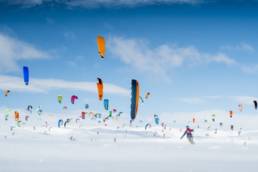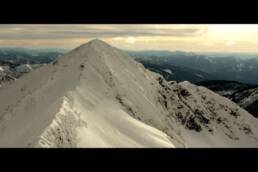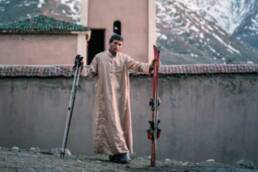These kite-skiing athletes have learned that travelling fast across large swaths of the Rockies is a breeze. By Matt Coté.
What’s the fastest way to get across a glacier? If you live in the Alps, where snowmobiles are banned, the answer for centuries has been two feet and your own heartbeat. If you live near Banff National Park, where motorized forms of transportation in the backcountry are likewise verboten, you’re in a similar situation: you better have a big backpack, rope skills, and lots of time. Or you could get a kite.
“You can do 20 kilometres in like 15 minutes,” says Lorenza Sommaruga Malaguti, a kite-skiing fanatic from Calgary, Alberta, who spends most of her free time in the nearby Rocky Mountains. Having a penchant for all things adventure related, Sommaruga Malaguti started kiteboarding in water, like most people do. When she realized the kite could also be a useful tool for winter ski mountaineering, she found an entire community of people out there already doing it and joined in the fray.
Over 300 snow kiters took part in the 2018 Red Bull Ragnarok event on Norway’s Hardangervidda Plateau. While the sport is not as popular on this side of the Atlantic Ocean, a growing community of kite skiers in Western Canada hope a similar competition will soon fly in their home territory. Top photo by Daniel Tengs.
Five years later, she’s one of the Rockies’ most prominent kite skiers and is a vanguard of the sport in Canada. “Like most of what goes on in North American mountains, Europeans started this first,” she explains. “It’s still bigger over there—in places like Norway’s Haugastøl and France’s Col du Lautaret—but it’s catching on here.” That’s because two of the things the Canadian Rockies and European Alps have in common are massive terrain and loads of wind. For this sport to work, you want a lot of open space with few trees, relatively clear weather, and a lot of airflow. While neighbouring British Columbia is famous for big snow dumps and pillow skiing, that’s not ideal for kiting. Plus, none of the glaciers in the British Columbia Interior are as expansive or accessible as those in the Rockies, like the Saskatchewan Glacier or Wapta Icefield, which can take days to traverse on skis.
While traditional forms of kite skiing are tailored specifically to zipping across frozen meadows or lakes, for which you use heavy, oversized, razor-sharp skis and powerful kites, the ski-mountaineering application is different. The kites are extremely lightweight and packable and hook directly into a climbing harness, which you already need for glacier travel. Sommaruga Malaguti says her lightest kite packs down to the same size as a full Nalgene water bottle, and weighs about as much, so there’s plenty of room in her pack for other mountaineering gear.
They decided Canada needed a kite-skiing event, seeing as every other snowy country has one.
“Who needs water? You can bring less when you’re moving that fast,” she quips. Her kite allows her to crush big approaches like the 2.8-kilometre-long (1.7-mile-long) Peyto Lake, on Banff’s Icefields Parkway, in 10 minutes. But modern-day kite skiers can actually climb mountains with them too. Once on top, they can pack the kite away and descend with ski gear. Sommaruga Malaguti has summited Cirque Peak, Bow Peak, and Wilcox Valley this way, and she has traversed the massively crevassed Athabasca Glacier en route to bag Mount Columbia, the second highest peak in the Canadian Rockies, which is usually a multi-day affair. She did it in one.
This is what makes it a notably different activity than speed flying—the hybrid version of paragliding that lets downhill skiers soar high above the ground as they descend. “Speed flying, you’re going down; kite skiing, you’re going up,” Sommaruga Malaguti stresses. The kites she uses are single walled, so it’s not often she catches any air time, but, she warns, they can still overwhelm and pull an unsuspecting amateur into trees or power lines. “It can be very, very dangerous. Everything happens so fast,” she adds. “People have died from going out without instruction.”
Thankfully, there’s plenty of instruction available throughout southern Alberta, along with a strong and growing community. The Facebook group Alberta Kite Crew has almost 1,600 members, and, underscoring the sport’s rising popularity, Red Bull supported the inaugural Rocky Mountain Snowkite Riot race in Sylvan Lake, Alberta, last March. For these types of races, participants compete to be the quickest across the lake, vying for gusts using more powerful kites and heavier skis than what they’d typically take into the mountains. Sommaruga Malaguti organized the race with the help of friends like Julia Barnes, whom she originally met river surfing. Barnes had been kite skiing for some time already, but Sommaruga Malaguti pushed her to use the kite as a tool to climb mountains and their stoke for the sport blossomed together. They decided Canada needed an event since every other snowy country has one.
“This sport means a lifestyle to me,” Barnes explains. “It’s an individual sport, but it’s so fun to actually do it in a group. Everybody came [to the Snowkite Riot] with just so much excitement, and they were just really revving to race. The atmosphere felt like a big, global race.” Unfortunately, the winds didn’t work out for the inaugural competition, but next year’s event will incorporate a bigger weather window to ensure the scores of hungry racers get their chance to stake Canada’s claim in this esoteric, elevating sport.
Matt Coté
Matt is the associate editor at Forecast. He's been penning and editing ski, adventure and mountain culture-based stories for over a dozen publications for the last decade.
Related Stories
Tree Skiing, The Sweetgrass Way
So many questions...how did they do it? How long did it take? Where was it filmed? The answers will be available next…
VIMFF
This is the introduction to the 2012 Vancouver International Mountain Film Festival. With films about mountain culture…
Frozen One
This comes from the creative geniuses housed up above the old post office in downtown Rossland, BC. Juicy Studios'…
Four Seasons
Nelson Kootenay Lake's Tourism has released a beautiful little short film about our region. Created by local director…
Skiing with Hassan
With rubber boots, berber tunes and an a-okay from allah, one giddy moroccan makes tracks in the atlas range. This man…
Selkirk Wilderness Launches Wintervention
Meadow Creek's Selkirk Wilderness Skiing just launched it's Wintervention campaign, a hilarious pairing of powder and…







